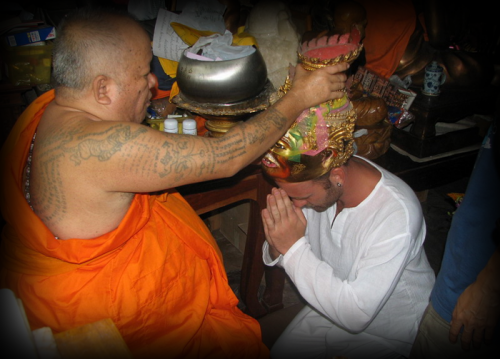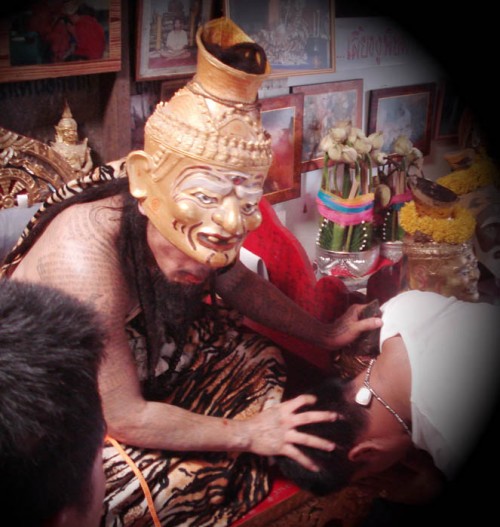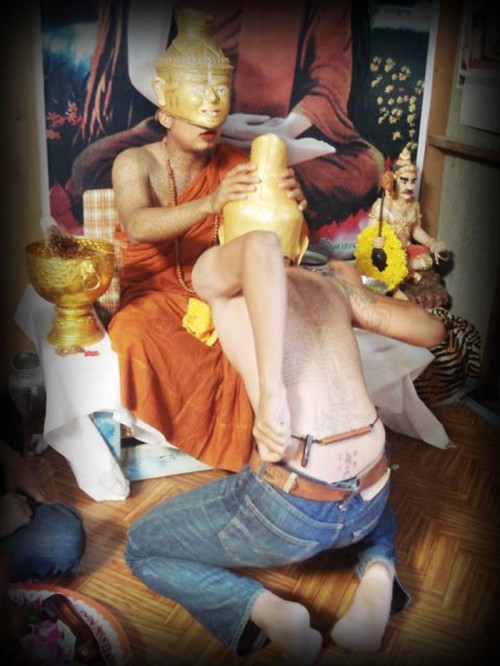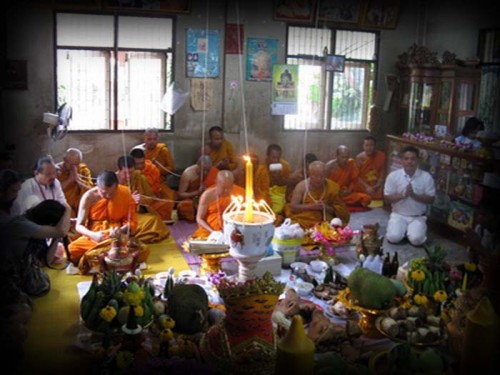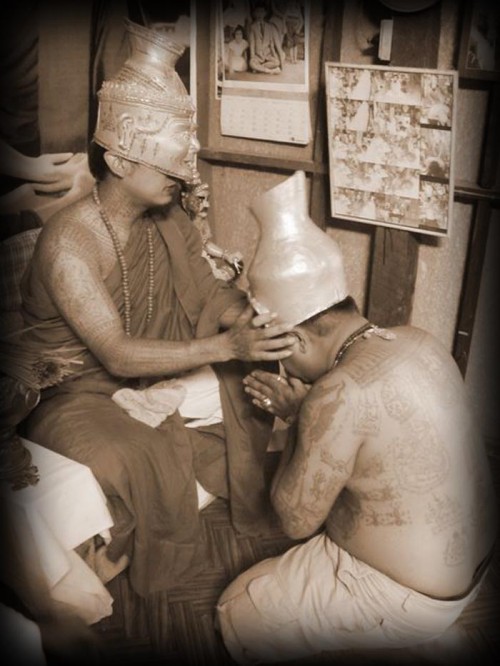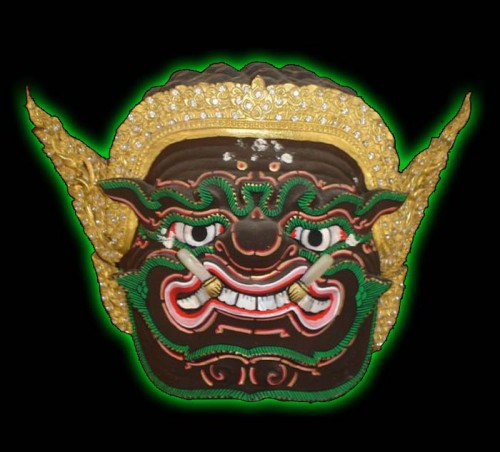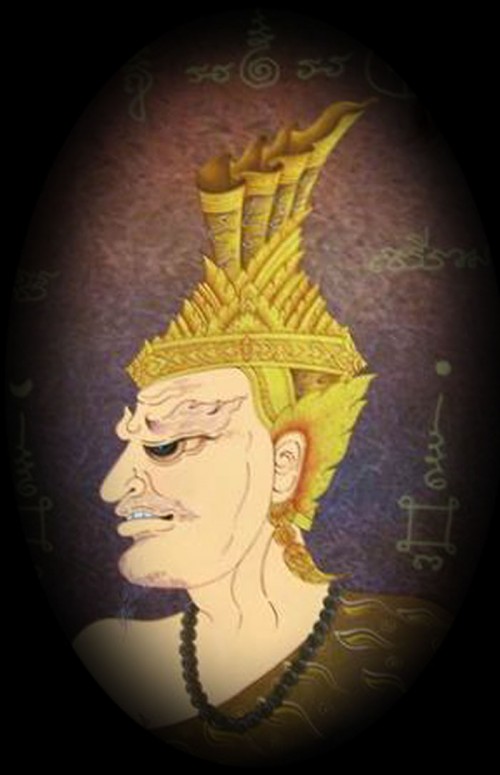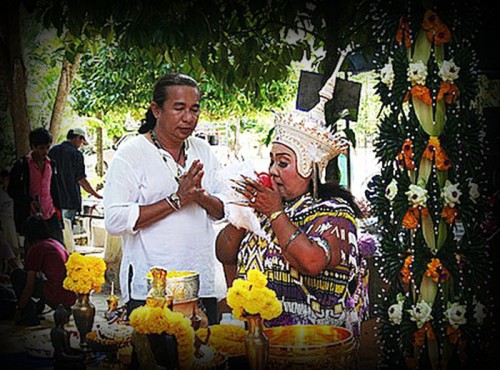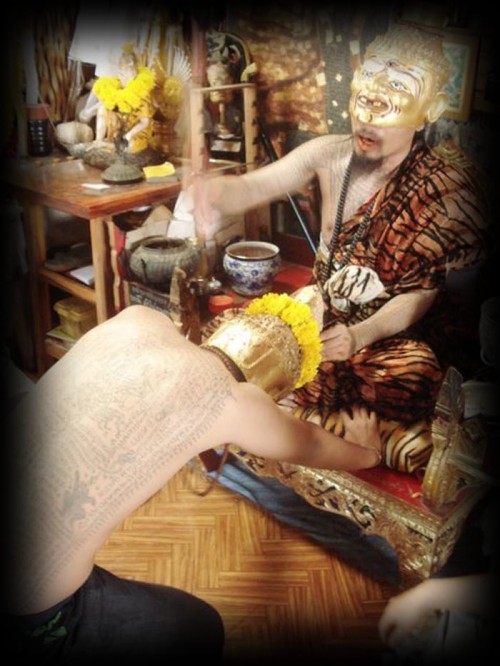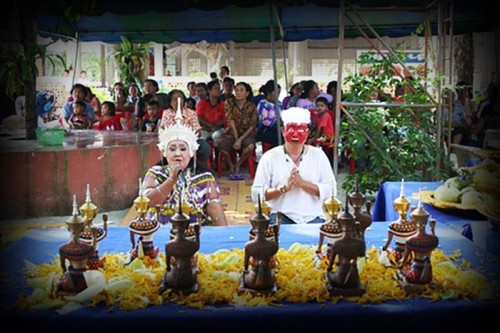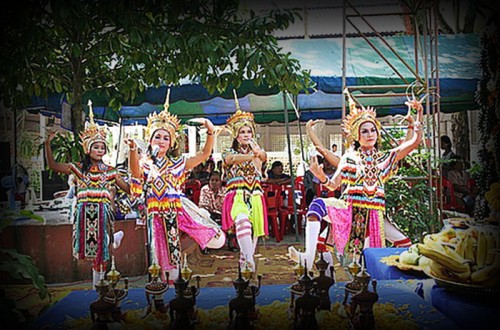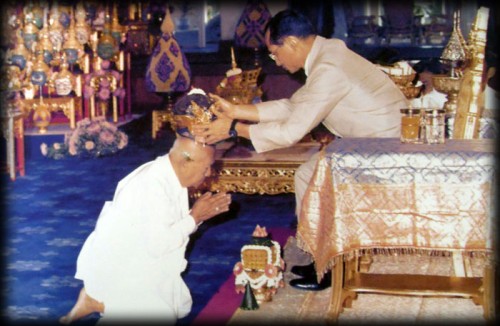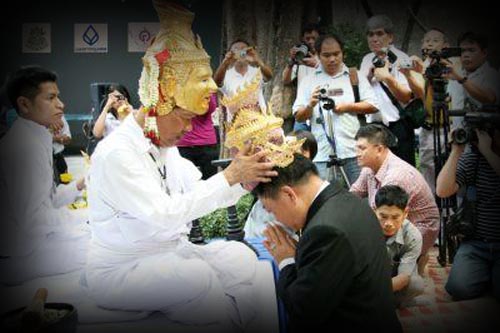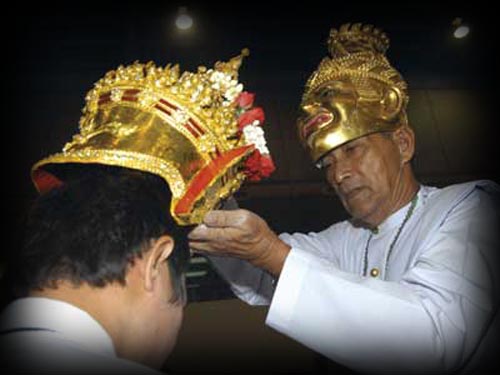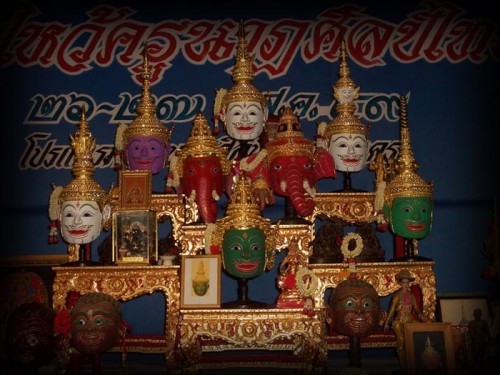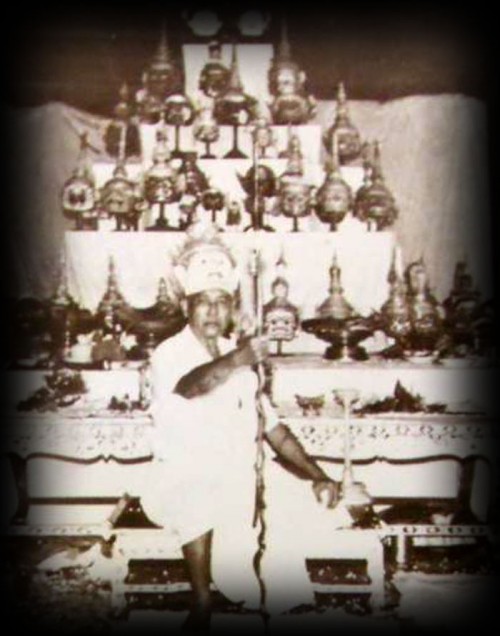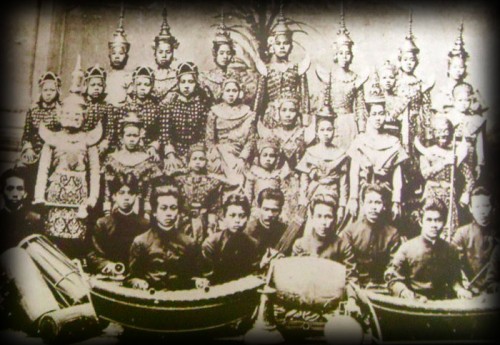Korb Kroo – Lersi Ta Fai Mask Initiation Ceremony
Korb Siarn Kroo means to lay the Lersi Mask of the Guru Master Ruesi (Por Gae) on the head as a blessing, Korb Kroo is performed once a Year during the Wai Kroo Ceremony. In Thai Saiyasart (Occultism), and Sak Yant Tattooing, it is Traditional to undergo the Laying on of the Lersi Mask of Ruesi Por Gae Ta Fai, or, depending on the Samnak or Ashram, perhaps a different or even additional Deity Masks may be laid on the heads of the Devotee, such as the Lersi Mask of Pra Pirab, Pra Lersi Narot,Taw Waes Suwan, Ruesi Chiwok, Lersi Paetchalugan, Pra Laks, or otherwise. The Ritual ceremony of Krob Kroo Siarn Por Gae Lersi Ta Fai is a ceremony that has gone hand in hand with Thai Society for Hundreds of Years. It is believed to bring great Auspicious Blessings to those who receive the Yearly laying on of the Por Gae Lersi Ritual Khone Mask
It casts out all Evil Influences and Black Magic, and transmits the Merit and Strengths of the Kroo Ba Ajarn (Por Gae) down through the Lineage Ceremony of Wai Kroo. Wai Kroo is very much similar to the transmission and Empowerment given by Tibetan Buddhist Masters. In fact, the Thai Brahman-Buddhist Lersi Occult Practices are very much comparable to the Vajrayana Tantric practices in many ways.
Krob Siarn is thus most simply Viewed as a Spiritual Transmission of the Lineage Powers of the Lersi Hermits, and of the Merits of all great teachers.
Who is Por Gae Lersi Ta Fai?
Ruesi Ta Fai, or ‘Por Gae’ is a Lersi hermit who has Mastered the Abhinya Samabhati of the Advanced Levels, and is an Expert in the practice of ‘Kasin Fai’ (Fire Elemental Control). He can stare at anything and make it be consumed in flames at a glance. He can make lead or Iron melt instantly. Pra Lersi Ta Fai has a Third Eye, which causes anything that passes within its view be burned to a cinder. Whenever this eye opens, what falls in its path is roasted in flame. It is believed that the Incarnation of Pra lersi ta Fai is an Avatar of Shiva**, who also has a Third Fire Eye of this kind.
** Note; In Hinduism, Shiva is the Never Born, and cannot Incarnate. This Thai belief in Lersi Ta Fai Being an Avatar is thus in conflict with Indian Brahman Cosmological Thought.
Other Lersi and Deva Khone Mask Wai Kroo Blessings
Apart from the Tradition of Krob Siarn Por Gae Ta Fai, different Samnak or Temples will additionally perform Blessings using Khone Masks of other Lersi or Celestial Deva Beings, Gods or Himapant Animals to bless the Devotees with. Sometimes this is because the Patron Lersi or Deva of the Samnak will be the Primary Blessing of the Patron Deva of the Samnak, and Por Gae as the Major Blessing for Magical Lineages.
One important Lersi especially for those involved with Astrology is Pra Pirab the Yaksa (Asura) Lersi. Pirab is actually the Thai name for the Hindu God Bhairaba, who is for the Tibetans one of the Yidam Protector Deities. Many Samnak indeed who perform the Krob Siarn Pra Pirab Ceremony, for Auspicious Blessings and Horoscope.
Amongst some of the more commonly seen Ritual Blessings with Khone Masks are; Hanuman, Pra Pikanes, Pra Laks Hnaa Tong, Por Gae Narot, Pra Pirab, Phu Jao Saming Prai (Tiger Face Ruesi) and Taw Waes Suwan.
Amongst the Rarer, or never seen ones are; Jao Ngo Pha, Pra Suk, Pra Ram, Mae Kali, Brahma or Vishnu.
Krob Siarn Hanuman – Wat Pai Lom Temple in Nakorn Patom
Origins of the Krob Kroo Ceremony in Thailand
The Origins of the Krob Kroo Siarn Khone is Officially Unclear, but is relatively obvious to reckon its most Probable Origins.
If we observe various Wai Kroo Ceremonies from Various Provinces of Thailand, and the Mountain Hill Tribes, we will notice not only Buddhist and Brahman inclusions in the Invocations of the Presence of Deities, rather, we can also observe the Invocation of an array of Animist or otherwise Occult Presences.
We can compare the Indian Hindu (Brahman) practice of Ceremonial Face Painting and dressing as Gods and Devas to perform recreations of various scenes from the Ramayana Mythology and Vedic Lore. In the Thai Wai Kroo Ceremonies, we can also see Ritual Dances with Celestial Beings represented by Dancers in Costumes styled according to Local Mythological and Artistic Interpretation.
We have thus, the Origins of one part of the Ritual ceremony of Thai Wai Kroo, where Devas are represented and perform Blessings. The practice of Wai Kroo in the dress of Celestial Gods and the use of Deities from the Brahman Vedic Lore and the Ramayana of Valmiki the Sage is directly descended from the practice of ritual dance and Poojah of the Indian Hindus, where dancing, with or without spirit possession, and throwing of blessed items (such as puffed rice) over the spectators, and of the Animist tribes of Thailand, with their nature Spirits added to the various Deva Buchas and Invocations seen in Wai Kroo, such as the Manora Wai Kroo Rituals of South Thai Occult Traditions.
Southern Wai Kroo and Putta Pisek Blessing of Nang Kwak Manorah amulets by Pra Ajarn Prasut at Wat Nai Tao temple
Above – Buang Sruang (Offerings) Ceremony for Kroo Mor Nang Kwak Manorah
We also see in Hindu, Chinese, Thai and Tibetan traditions the Phenomenon of ‘Rang Song’ (Thai) ‘Dang Kee’ (Chinese) – Possession or Spirit Mediumship of a Deity within the body of a Human Medium. Many of the Thai Lersi Hermits, Sak Yant Masters and ‘Prahm’ (Brahman Sorcerors) perform Mediumship and Don the personality and the Deva Mind of Por Gae Ta Fai, or any of an array of other Deva Beings, and perform Blessings, and Sak Yant, Healings and Sorcery for their Looksit.
This is very much Sorcery and Occult related but also has strong Buddhist leanings in many of the Formulas and Incantations used to Empower the Spells and Amulets which many of the Lersi and Guru masters make.
This is the Occult Aspect of the Wai Kroo
The various Devas and Spirit Beings, Animist Entities included in Wai Kroo Ceremonies are derive from both Local Tribal beliefs in Nature Spirits (such as the Mae Posop Rice Harvest Deity, and the Mae Takian Prai Tree Spirit Deva, Pra Khun Phaen and the Kumarn Tong) and Brahman Deities.
The inclusion of Dances that Invoke or Represent these Deva or Spirit Beings are performed by trained Classical Dance Performers, and accompanied by trained Classical Musicians using Traditional Ancient Instruments of Vedic Lore, sad to be the instruments invented by the Lersi Hermit Deva – Lersi Narod (Naradha).
Please click below image to read the Conjecture in the Description text on the attachment page for this picture.
Cultural and Historical Influences
The third Aspect is that of the Historical and Cultural one, and is much less Mysterious, but very full of Tradition and Culture, and of great Anthropological Interest.
Above; Royal Krob Kroo Ceremony of Kroo Lersi Pra Pirab, with His Majesty the King Bhumipol Adulyadej (Rama 9) performing the Blessings.
Krob Siarn Kroo Naatasin Thai
Naatasin is the Classical Ramakian Dance Theatre where the Performers wear ‘Siarn Khone’ (Khone Masks). The Wai Kroo Naatasin (Pay respects to the Lineage of Classical Dance Performing Arts teachers). As in all Wai Kroo Ceremonies, the Wai Kroo of the Thai Classical Dance Performing Arts begins with Krob Siarn Khone. The creation of Khone Masks and the development of Thai Naatasin Dancing Performing Arts must have a major role in the Adoption of the Krob Siarn Kroo Lersi Mask Ritual.
Amalgamation of the Lersi Mask Blessing into the Lineage Transmission Ceremony as ‘Krob Kroo ‘
The Lersi Masks are part of a large pantheon of masks depicting Celestial and Mythological Beings. The Masks themself are called ‘Siarn Khone” in Thai, and are a product of the Thai Classical Khone Theatre performing Arts. The Bucha (Worhsip) of the Khone Masks, and the subsequent Laying on of the Mask as a Blessing has been a practice of the Thai Classical performing Arts as a Tradition for as long as we can remember. The Mystical Practice of the Lersi Mask Krob Kroo Blessings is presumed to have arisen and developed from the Khone Mask Performers, who would perform a Yearly Bucha Kroo Ceremony in Thai Brahman Tradition to worship and ask for Blessings and Protection from the Deity of the mask the performer wears in Performance. Someone who plays the role of Hanuman for example, should receive Krob Kroo of the Hanuman Khone Mask, as well as of the Lersi.
It is highly possible that the method used for Transmission of protective Blessings used by the Lersi Hermit Sorcerors was adapted and changed to incorporate the Thai Khone Theater Mask as part of the Ceremonial Methods. It is obvious that the Ancient Practices and Wicha of the Lersi, which developed from the Brahman Rishi Way mixed with local Siamese Animist practices has had a Transmission of Lineage ceremony for thousands of years, but it is also obvious that the practice of Krob Kroo Blessing using the Khone Mask as an object of Transmission, can not be older than the Khone Theater itself.
A thousands year old Lineage of Masters (the Lersi) must have had its traditional Transmission of Power rituals since the very beginning, which proves in the opinion of common sense, that the Krob Kroo Lersi Mask Ritual is a more recent development, and not an essential part of the Ancient Ceremonial Methods, rather a Cultural Development, or perhaps, the creation of a new form of the Wicha, with its own inherent powers, which draw the essence of its power from the Root Gurus of Old just as successfully as any previous conditioned methods..
It seems that as the advent of Lersi-Ism in Thailand has begun to become ever more popular and more widely practiced in Public, the practice of the Krob Kroo has also grown and been adopted. However, as it has been adopted, no documentation of the adoption process has been made, resulting in the common assumption that
1. A devotee must receive the Lersi Mask blessing to correctly practice Lersi Devotion
2. The Krob Kroo ceremony using Lersi Khone Masks has been around since the beginning of the Lersi Hermit History.
The mistaken assumption lies in the fact that, yes, the Devotee must receive Lineage transmission and protective blessings, but, this does not mean that the only ritual ever to have existed and to have been valid, is that of the Lersi Mask Krob Kroo Ceremony. In Vedic Times, the Rishi of India had not Thai Khone Masks to Transfer Merits and Blessings of the Lineage with, so how did they do it? This remains to be researched and discovered.
What is for sure, is that if we understand the roots and causes behind traditional Ceremonies we use in our Practice, we will have a deeper understanding of its meaning and role as a Mystical Practice, and be able to benefit from the Ceremonial Event without any false understanding of its meaning. Our Faith will be able to focus on the Principle behind the Object, and connect with the Transmission of the Lineage with our Heart, instead of not seeing beyond the Physical Object of the Mask. The Mask is something to help our minds to connect to the Devas and the Lineage of the Lersi, but it is the Faith Principle and the Concentrative Focus (Samadhi) which arises with faith or Pure Intention, and connects with the Lineage of the Kroo Ba Ajarn, not the Mask. Symbols cause our minds to awaken Magic, but the symbol itself, without an observer, does not exist.
This is one of the Cultural Aspects of Wai Kroo
The Lersi Por Gae, Narot, Pirab and all the other Devas can mostly be found to exist within the stories told in Thai Dance Theatre. We can quite safely assume, that the Thai Naatasin dance Theatre Arts were the original cause of the Khoe Theatre Mask Artisanry becoming a profession, and for the masks to then have been incorporated by the world of Thai Sorcery. It appears that it has not been longer than perhaps 60 or 70 years that the first ever ceremony of Krob Siarn was officially performed in the Royal Thai Performing Arts
Khone Masks of various deities and characters who appear in Vedic Lore and the Ramayana (Ramakian in Thai) Epic Legend written by the Lersi Hermit Valmiki.
It seems that as Buddhism and Occult Practices along with Brahman Ritual became amalgamated into what is now Thai Buddhism, the Animist practice of dancing to the Devas and Spirit Mediumship, and the practices of face painting were dropped, and mask making became adopted instead as Thailand developed its own Cultural and Mythological Interpretations, that the Khone Masks somehow became adopted as part of the Ritual, and that the laying on of the Mask was begun as part of the method of Transmission of Blessings.
What is for certain, is that the practice of Krob Siarn Lersi Por Gae, can not be as old as Por Gae himself, and can not be older than the date where the first Khone Mask was created in Thailand. The Thai Classical Performance Arts, be it Dance, Khone Mask making, or Classical Music, play a Major Role in the Development and Ceremonial Methods used in Wai Kroo and Krob Kroo Ceremonies, and are the central hub of knowledge that can be found Officially Recorded. The Nature of Thai Sorcery is so secretive that not truly detailed information is publicly or officially noted or accessible, whereas the Cultural research Info available leaves an Anthropological study of the Cultural side of the Ritual Ceremony much more open and accessible for research.
The completion of a comprehensive investigation into the beginnings of the Wai Kroo as a Cultural State Ceremony for the Performing Arts is thus the next step in Investigative reporting of the Lersi legends and the Quest for Truth in the sacred Knowledge of the Ancient Hermit Sages; The Lersi.
To Understand Fully from both a Spiritual and Anthropological sense, one should study the History of Thai Dancing Arts, Khone Mask Arts, and the Various Differences in Ancient Indian Hindu practice, Buddhist practice, and its integration with Thai Sorcery.
Perhaps the Thai Lersi Hermit Practice is only partially derived from the Indian Hindu Rishi practice, and that this is what makes the Thai Lersi path Inimitable. Despite its Brahman roots, it has become its own form of practice, but has recognizable roots and influences coming from a multitude of causes. Perhaps the Wai Kroo and Krob Siarn Lersi Por Gae is strongly derived from the ancient Brahman practices, with Local Tribal and Cultural beliefs and Ritual Practices infiltrating, to develop into its own Wicha, which has become even deeper and more complex than any of the Ritual Practices of the Cultures and Belief Systems which lent a part in its development.
Please click all images in this page to read small informational captions in the attachment pages
In Truth, without the Influence of Sorcery, for Thai Culture, the Ceremonial Krob Siarn Kroo Blessing is a Ritual remembrance Ceremony to pay Respects and Reverence to the Kroo Ba Ajarn, the teachers who have benefited Us in Life, and to remember their teachings and their goodness in teaching us.
But with the Influence of Sorcery, If the person who undergoes the ceremony and receives the Blessing of the Siarn Kroo has Moral precepts (5 Buddhist Precepts), and is not with Evil in their Hearts, and practices then Dhamma, then the benefits and Blessings of receiving the laying on of the Kroo mask and the Invocation of the Lineage will be Plentiful. But if the person receiving the Blessing is not pure of heart and does not have Morality, then Great Ill Fortune could befall that Person, and more damage than benefits would be obtained from the experience.
Related Links
Por Gae Lersi Ta Fai
Bucha Kroo Isan Style – What to Offer and Chant at Wai Kroo Ceremony
